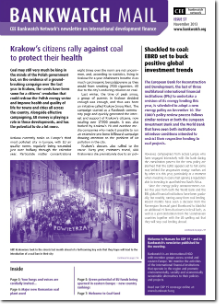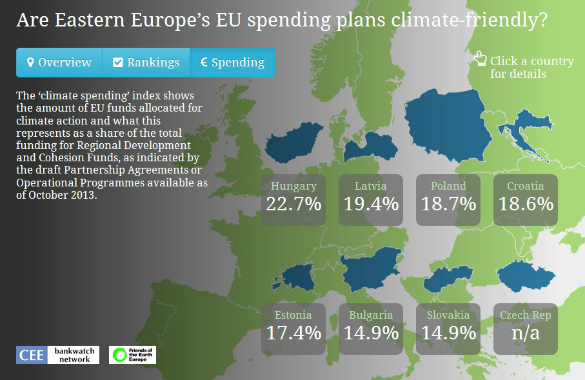“Job creation, reduced energy bills, cleaner environment … hmmm” – eastern member states failing to grasp EU Budget’s green potential

Bankwatch Mail | 11 November 2013
With only a few weeks to go until the end of the year, and the official start of the new EU budgetary period for 2014-2020 that will see billions of euros flow into central and eastern Europe (CEE), national governments are racing to finalise their EU spending allocations for the forthcoming seven-year period. But, according to new analysis and a data visualisation put together by Bankwatch and Friends of the Earth Europe, CEE member states look set to pass up the opportunity to devote adequate funds for green projects and initiatives.
This article is from Issue 57 of our quarterly newsletter Bankwatch Mail
Browse all articles on the right
The data visualisation, to be formally launched on November 18 during the COP 19 meeting, scores eight CEE countries – Bulgaria, Croatia, the Czech Republic, Estonia, Hungary, Latvia, Poland and Slovakia – on the basis of assessments made by experienced national EU funds campaigners on the inclusion of climate change considerations in current national programming plans. Factors such as the existence of mitigation and adaptation strategies, the creation (or not) of institutional means for monitoring the implementation of climate-related measures, and others have been taken into account.
One year ago, the European Commission proposed that 20 percent of the upcoming EUR 960 billion EU Budget be dedicated to climate measures. Such a financial commitment, agreed to by EU leaders at a summit meeting in February this year, constitutes a once-in-a-lifetime opportunity to boost the decarbonisation of the CEE states, the most energy intensive in the EU and still heavily reliant on fossil fuel derived energy generation.

As of October 2013, the proposed allocations going to climate spending as a percentage of Regional Development and Cohesion Funds in the CEE states for 2014-2020.
According to Markus Trilling, EU funds coordinator for Bankwatch and Friends of the Earth Europe: “With the EU Budget clock ticking down fast to January 1, 2014, we decided to have a look and assess how far CEE governments are taking advantage of this tremendous opportunity for green spending, spending that can do so much for jobs, reduced energy bills and people’s quality of life more widely. Unfortunately, the answer is – not enough.”
Bankwatch/Friends of the Earth’s ‘climate conscious’ rankings of eight CEE countries’ EU spending plans for 2014-2020
(scores awarded are out of 18)
| Slovakia | 9 |
| Estonia | 8 |
| Hungary | 7 |
| Poland | 7 |
| Croatia | 6 |
| Latvia | 6 |
| Bulgaria | 5 |
| Czech Republic | 5 |
